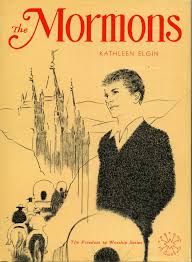Articles/Essays – Volume 05, No. 3
Another View of the Mormons | Kathleen Elgin, The Mormons: The Church of Jesus Christ of Latter-day Saints
The Mormons is the second in the Freedom to Worship series designed to tell stories of “outstanding Americans of the nineteenth century and their different religious beliefs.” The series is intended to fit into the Social Studies curriculum for grades 4, 5 and 6. Kathleen Elgin also wrote the first book, The Quakers.
An introductory chapter of The Mormons tells of the westward migra tion and introduces Charles Rich as an outstanding Mormon leader. The second chapter, comprising almost half the book, tells of Charles Rich’s ex periences and work in the Church from the time of his conversion to the terms he served in the legislature of the Territory of Utah. The third chap ter summarizes the history of the Church from the first vision of Joseph Smith to the successful colonizing of the West, and the fourth chapter answers such questions as “What is the Book of Mormon?” “Did They Practice Polygamy?” and “Why are Non-Mormons Called Gentiles?” A brief chapter discusses the growth and activities of the Church today, and the book con cludes with a list of “Some Famous American Mormons of the Nineteenth Century and of the Present Day.”
Numerous black and white illustrations by the author are perhaps the strongest feature of the book. Mormons may also appreciate the sympathetic treatment, although some might prefer a more historical objectivity.
With the exception of minor factual errors (such as credit to Ezra Taft Benson and the Mormons for laying the final rails of the Union and Central Pacific Railroads when in fact what they did was prepare roadbed) the book is accurate. However, church concepts are presented in a way that demands a greater knowledge of religion, and specifically the Mormon religion, than most students have.
The major weakness of The Mormons is that while its aim is admirable, it is not written in a way that will hold the interest of young readers and give them a clear understanding of why the Mormons in general and Charles Rich in particular colonized much of the western United States. Nor will a school child understand what the Mormon religion is about. In choosing to tell the story of the Mormons by telling the story of Charles Rich, the author followed the intent of the publishers to tell the story of a great American motivated by religious faith. However, the book is organized so that Rich’s story is a hurried account of what he did without an integration of character and beliefs that explain his motivation. Not only is this organization confusing, but it does not leave time in the section dealing specifically with Rich to treat his life with enough depth and drama for a child to imagine and become involved with his work and problems. Furthermore, the responsibility of the author to develop the events of Rich’s life with sufficient detail and action is particularly great since his story begins when he is twenty-three years old and there is nothing he does with which a child can easily identify. Beliefs of the Church are not seen as forces for joy and success in men’s lives.
Since this book is supposed to show a nine- or ten-year-old child the contribution of Rich and the Mormons to the Westward Expansion, the material could have been presented in a more appealing and understandable way. It is unfair to expect a child to check this book out through choice; even a Mormon would put it back.
The Mormons: The Church of Jesus Christ of Latter-day Saints. By Kathleen Elgin. New York: David McKay Company, Inc., 1969. 96 pp. $3.95.


 Back to full Issue
Back to full Issue

